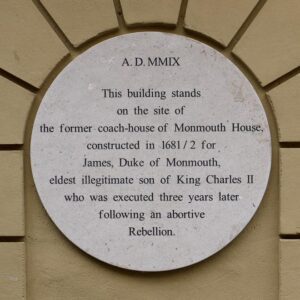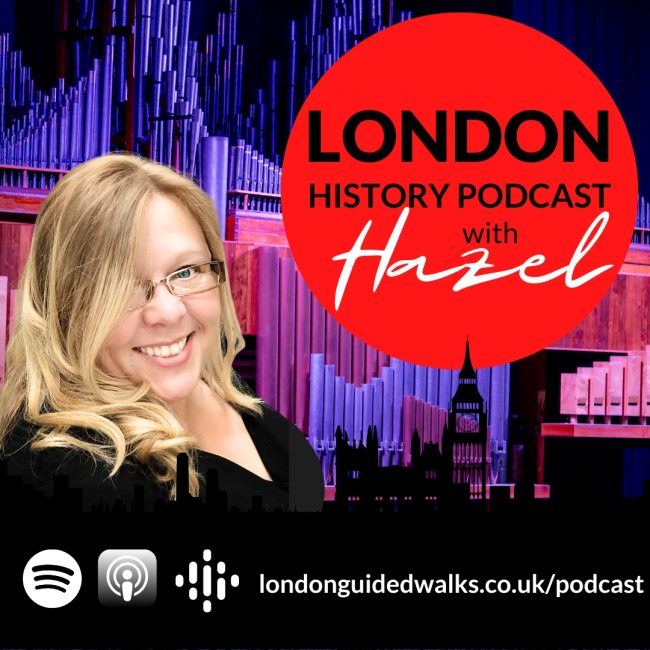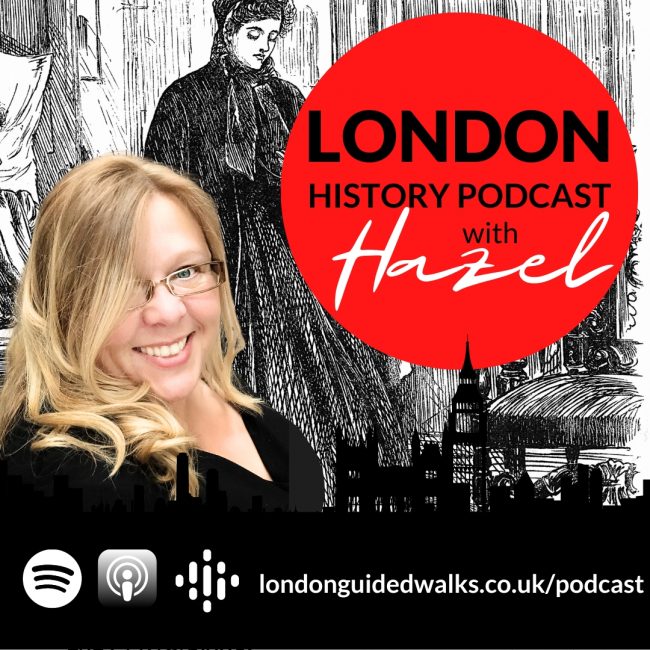Join tour guide Hazel Baker and historian Andrea Zuvich talk about the life and loves of James Scott, the first Duke of Monmouth aka the doomed Duke. Immerse yourself in the Stuart court in this 20 minute episode.
London Guided Walks » Episode 62: James Scott, the First Duke of Monmouth
Episode 62: James Scott, the First Duke of Monmouth
James Scott, the First Duke of Monmouth
Recommended Reading:
Show Notes:
 Hazel Baker: Hello and welcome to London Guided Walks London History podcast. In the coming episodes, we will be sharing our love and passion for London, its people, places and history in an espresso shot with a splash of personality. For those of you who don’t know me, I am Hazel Baker, founder of London Guided Walks, providing guided walks and private tours to Londoners and visitors alike.
Hazel Baker: Hello and welcome to London Guided Walks London History podcast. In the coming episodes, we will be sharing our love and passion for London, its people, places and history in an espresso shot with a splash of personality. For those of you who don’t know me, I am Hazel Baker, founder of London Guided Walks, providing guided walks and private tours to Londoners and visitors alike.
Elizabeth I was the last monarch from the House of Tudor. The House of Stuart took over the thrones of the Kingdom of England and the Kingdom of Ireland, providing the head of all three states between 1603 and 1714, under a personal union.
It was an eventful time, from the gunpowder plot, civil war, the great plague, the great fire of London and the Glorious Revolution. We cover the Stuarts on our Wonders of Whitehall & Heretics and Horrors walks and dive a bit deeper on our Great Fire of London walk.
Today we are going to be talking about the Duke of Monmouth, ill-fated illegitimate son of King Charles II. This may ring a bell to some of you who have listened to episode 27: The South Sea bubble or indeed have been on our Nosey around Soho walking tour. Joining me today is Andrea Zuvich.
 Andrea Zuvich
Andrea Zuvich
Andrea is a historian specialising in the late Stuart period, 1660-1714. Andrea was one of the original developers of the Garden History Tours at Kensington Palace. She has published 6 books on the Stuart period, including Sex and Sexuality in Stuart Britain, released in 2021, and she is currently working on a biography of Charles II’s notorious mistress, Barbara Villiers.
Hazel Baker: Today, we’re going to be talking about James Scott, the first duke of Monmouth, Andrea, if you would mind, let’s start with his family.
Andrea Zuvich: James Scott was born in 1649 in Rotterdam, in the Dutch Republic, as it was then known. His mother was a wealthy royalist exile named Lucy Walter. Now Lucy and Charles had a passionate relationship, Charles seemed to go off her after a while. James was born only a few months after Charles I (his grandfather) had been executed.

He was not very well-educated in his early years. And he was pretty much passed from pillar to post. He was kidnapped from his mother by his, there was at least two attempts to kidnap him.
Lucy Walter died in poverty after suffering from some disease. We don’t know what that is, but her enemies, including the second said that it was some venereal disease. So as you can see, it’s all tying into that whole loose woman storyline.
James had a very difficult upbringing. He didn’t have the best parents in the world. And many people, I think today and throughout history could see a connection with that, with this, some troubled family dynamic there, but pretty soon after he became he was brought to the court after the restoration in 1663.
On 14 February 1663, at the age of 13, shortly after having been brought to England, James was created Duke of Monmouth.
He was married off very young. He was about 14. His father had arranged a marriage to a very wealthy heiress. Her name was Anna Scott and the Duchess of Buccleuch. And so James Scott became the Duke of Buccleuch.
Hazel Baker: She was just a year or so younger than him, wasn’t she?
Andrea Zulvich: I think she was just 12 at the time. Yes. But I’d like to say right now that this is not common in the Stuart period. Right? Charles himself, when he wrote to his sister in Henrietta, he said that they were going to have the bedding ceremony and everything.
Everything was, is going to be normal, but. The two youngsters would not be able to spend the night together. They weren’t to have sex because they were far too young. And the belief at the time was that it was dangerous to have people engage in sexual congress at too young an age. They thought this was potentially damaging. I always have to say that because lots of people think that that’s pretty common, but in fact, it wasn’t. And they as a society, were not into child marriage.
So he was married and he began to take after his father Charles II, as in that he had a roving eye. Jimmy, as his father referred to him, became quite a philanderer and very much part of the whole restoration libertine scene. We have John Wilmot, second Earl of Rochester over here, who liked to write really wordy poems. And we have a sort of hedonistic vibe if you will, all throughout the court. And there were very loose morals, people were having it on with the ladies in waiting and all sorts of things.
It was not that. More sort of sphere at the time which is very different in, in many respects to the cultural zeitgeist that was prevalent just in the previous few years under the interregnum.
Hazel Baker: I think that happens in society though, is when you go too far, one way. The best way to counter that balance is to go too far the other way. The fashion as well with women just literally only see those, those portraits of Charles II’s mistresses and they’ve all got their dresses ready to just pull the ribbons and then become undressed. And there’s all of that, like eating to excess that you just hadn’t with the Puritans.
Andrea Zuvich: No, indeed. That, so, so Peter Lely is very seductive. There was this great cultural shift at this point. But whether it impacted people further down in society, that’s, that’s debatable because people still had to think about how to keep to their social place.
And there was a great deal of ostracisation and there was fear of being persecuted for anything that could be perceived deviant or outside the realms of acceptable behaviour.
The Stuart era masque is something I’d like to talk about. It was a costly, splendid, magnificent, theatrical spectacle. Although these sumptuous entertainments are usually associated with the early Stuart courts, particularly the Jacobean and the Carolinas, there was one in particular during the restoration, in which the then 26 year old Duke of Monmouth was involved in; and this masque wasn’t titled Callisto of The Chaste Nymph. It was performed at the Banqueting Hall of Whitehall Palace in 1675. And it was written by John crown and the masque boasted of a cast, which was a veritable who’s who of 1670’s restoration England.

One of the ladies performing was young Henrietta Wentworth, and she was 14 years old at the time. And she played the part of Jupiter and other people in the cast included the future. Queen Anne and Queen Mary II. So there were some very important figures at the time who were involved in this production and it was a very costly affair.
I think one of the ladies had a dress that was worth £300 and at the time that was extremely expensive. So that just gives you an idea of how, how expensive this sort of entertainment was. This was in 1675 and Monmouth was at this time still attached to his mistress, Eleanor Needham. In 1680 he began to pursue Henrietta Wentworth in earnest. This scandalized the court because she was supposed to marry someone else who was a much more of an upright and respectable man but she succumbed to the seductions of the bad Duke of Monmouth. I can’t really blame her, really. They continued their affair in secret.
Monmouth took refuge at her home in Torrington Manor in 1683, following the disastrous Rye House Plots. But she was implicated.
The Rye House Plot was one of several plots that were supposed to kill Charles II and his brother James and replace them.
Hazel Baker: The big names, there were the Duke of Monmouth, the Earl of Essex, and also Lord Russell. And it’s something that we cover on our Ghosts and Gallows walk.
So what are the London locations which would have been significant for the Duke of Monmouth? Whitehall Palace was one of them, wasn’t it?
Andrea Zuvich: Yes. He had rooms at Whitehall Palace and was involved in many of the court intrigues. Major events happened at that palace. You could still visit the Banqueting House and it’s beautiful with that beautiful Rubens ceiling.
Hazel Baker: It’s exquisite, isn’t it? The building in and out.
Andrea Zuvich: Oh, There’s so much history there. It’s just oozing history. It’s wonderful.
Hazel Baker: So we have Whitehall palace, which was the epicentre of all these fantastic masque balls and the banqueting house where they took place. We also have Monmouth’s house, which was on the south of Soho Square where the Bateman Buildings are now there’s a little plaque. But the tower of London and Tower Hill is, kind of, a special place.

Andrea Zuvich: Charles II had possibly what they call the fit of apoplexy, he might’ve had a stroke. It was some kind of stroke. And I think, as do some other historians, that he probably would have survived had it not been for the horrendous medical treatment that was given in the hopes of what was given to him to cure him, probably finished at any rate.
Monmouth was at the time in the Dutch Republic at the court of William and Mary. They were getting on really well. He was there with his mistress Henrietta Wentworth. I believe there was a ball that he was at, and that’s when he received word that his father, Charles II, had died.
Of course there was a lot of controversy at the time because some people thought that Monmouth was legitimate, meaning his parents had been married. And if that was the case, he would be the legitimate heir to the story. But many others said that he was illegitimate. And so he was not a legitimate heir to the throne.
Charles II’s brother, became king James II of England and VII of Scotland. And then we start the trouble.

Monmouth did not accept this. He was around people. There are some malcontents and people who like to stir the pot, really. And they said, well, you know, it’s really you who should be king, you are the eldest son, you are a Protestant; a Protestant king for a Protestant nation, etc.
And so he started buying into all of this and pretty shortly thereafter, he started his plan to have a rebellion and invade, and there was a pretty substantial amount of support for him.
But unfortunately, everything came to a terrible end and the Monmouth rebellion was crushed.
The Duke of Monmouth was sent to London, to the Tower of London. And there, he sent letters to the new king James II and to the Queen dowager, Catherine of Braganza, the widow of Charles II. He pleaded for his life. He begged for mercy, but he didn’t receive it.
In July he was taken out of the Tower of London up on Tower Hill, the site of many executions in the early modern period. We remember this one as it was one of the most notorious executions in British history because it was a botched job.
It took Jack Ketch some five to seven blows in order to behead him. It was an horrendous spectacle, gruesome, one of the most horrendous things that could possibly be seen and the people who were there, they were utterly aghast. They were even angered by his cruel and incompetent handling of the execution by Ketch. They started shouting at him and booing and everything because this was horrendous. And there were many people who did have some sympathy for the Duke in this completely horrific situation. Ketch, after pretty much giving up a few times, he had to finish it off with a knife. It’s one of the grizzliest things I’ve ever had to research. And this was at the time when such events were entertainment, for lack of a better word, really. And they still thought it was horrendous. So that shows how horrible it was at the time.
His mutilated remains were taken back into the Tower of London. His wife could have taken one away to one of his homes, Moore Park, but didn’t and so his remains were interred inside the chapel of St. Peter ad Vincula where Anne Boleyn and Katherine Howard are also buried to this day. Visitors to Tower Hill are able to see the Memorial plaque which contains Monmouth’s name as well.
In terms of his personality Monmouth had an amazing charisma that I believe his father had as well. People were willing to give their lives for that cause. There’s something quite poignant about his tragic life. I mean, he was, he was so young, it was one of the tragic tales of the Stuart period. And I wish more people would know about that.
Hazel Baker: For those who aren’t able to see, I’ve got a photo of the plaque that’s at Tower Hill so you don’t have to miss out there, just check the show notes.
I’m just thinking about knowing that you’re going to be executed by Jack Ketch and knowing that Ketch has messed up beforehand, how would he have felt knowing that it could be a possibility that he is potentially going to have a difficult and painful execution?
Andrea Zuvich: If the reports are correct, he supposedly said, “Do not hack me as you did my Lord Russell.”
In Ketche’s defence, he was used to doing hangings, not beheadings. This was not something that he did regularly. So he didn’t have a great deal of practice.
Hazel Baker: Andrea, thank you so much for sharing your, dare I say, love of Duke of Monmouth with us today.
Andrea Zuvich: I have a great amount of warmth towards him.
Hazel Baker: I don’t see how you can’t knowing his upbringing, knowing his lack of education, knowing the people that would have been surrounding him when his father did die out, whispering in his ear. And if you’re a sort of weak personality, really, you’re going to be swayed. You’re going to be really impressed that people are willing to put money behind your campaign. All of these people that you love and adore around you are supporting your claim to the throne.
Andrea Zuvich: He was very malleable and that’s the thing with him. He was easily led though. He was a very courageous man. He was a great military leader.
He had a commanding presence and I think that Monmouth has so much, that is alluring and, and, and I, I believe he is what I’d call the, the dashing, but doomed to duke because he had all of these attractive qualities. And yet he wasn’t inherently doomed. Thank you so much for having me.
Hazel Baker: Check out Andrea’s book:

That’s all for now. See you next time.











